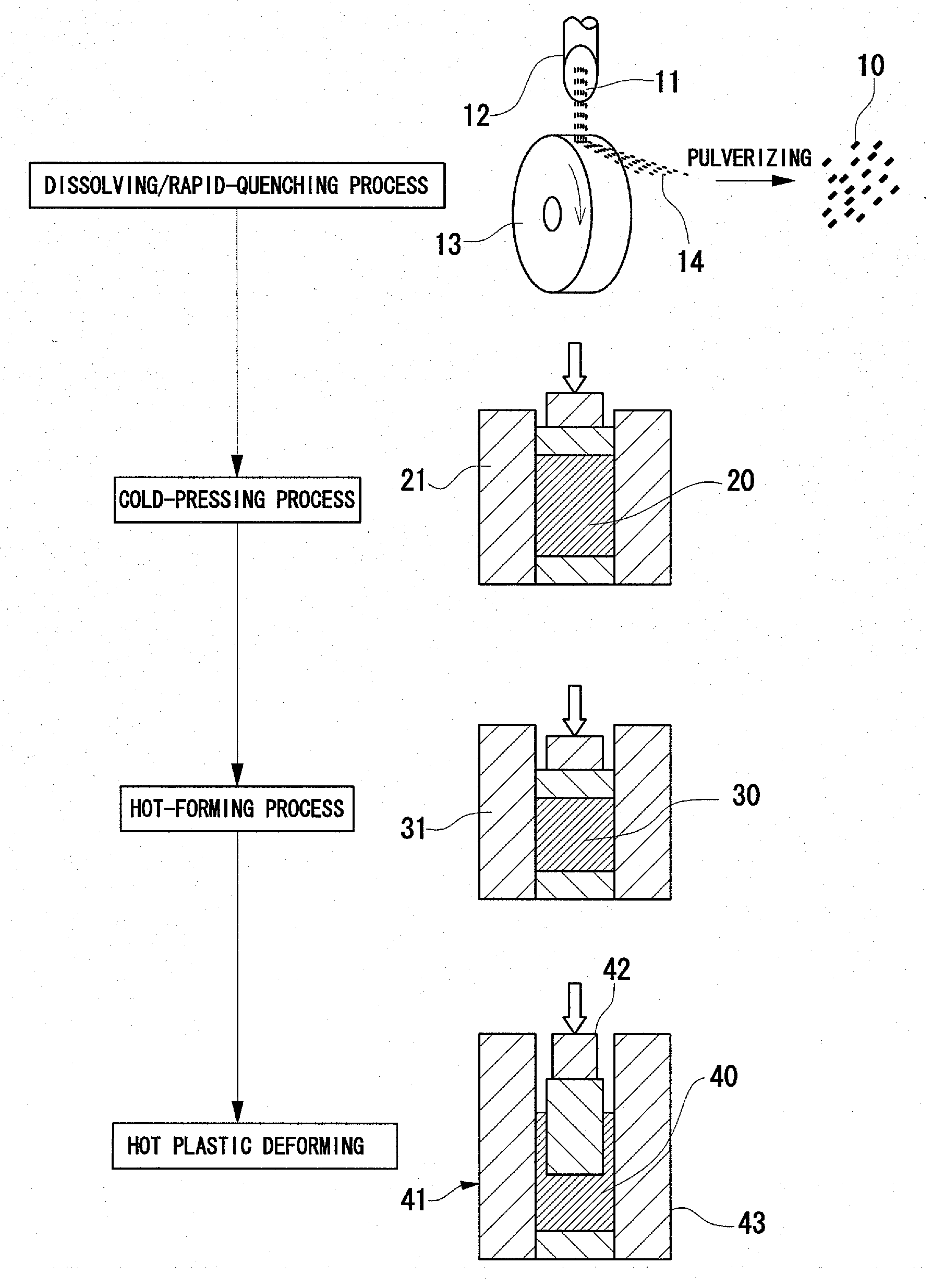Material for Anisotropic Magnet and Method of Manufacturing the same
a technology of anisotropic magnets and anisotropic materials, which is applied in the direction of magnetic materials, magnetic bodies, transportation and packaging, etc., can solve the problems of insufficient coercivity, insufficient remanence, and inability to achieve sufficient remanence, so as to improve remanence and coercivity, the melting point of grain boundary phases is relatively reduced, and the effect of smooth rotation
- Summary
- Abstract
- Description
- Claims
- Application Information
AI Technical Summary
Benefits of technology
Problems solved by technology
Method used
Image
Examples
example 1.1
1. Manufacturing Specimen
[0128]A molten alloy having a predetermined composition was rapidly-quenched. Then the obtained ribbon was pulverized, thereby alloy powder was obtained. The alloy powder was cold-pressed and the cold-pressed body was hot-formed. Further, hot plastic deforming was applied to the hot-formed body, with the result that a material for anisotropic magnet was obtained.
[0129]The composition of the alloy was PrxFe94.05-xB5.5Ga0.45 (x=12.0, 12.5, 13.0, 13.5, 14.0, 14.5, 15.0, 15.5, 16.0, including inevitable impurities).
[0130]Further, condition of pre-heating and hot-forming are respectively as follows:
[0131](1) (in the case that pre-heating is performed) pre-heating of 750° C.×10 minutes, and hot-press of 815° C. (a temperature of a mold); or,
[0132](2) (in the case that pre-heating is not performed) hot-press of 850° C. (a temperature of a mold).
2. Method of Test
[2.1 Magnetic Property]
[0133]The material for anisotropic magnet was magnetized and the magnetic properti...
example 1.2
1. Manufacturing Specimen
[0149]A material for anisotropic magnet was manufactured in the same method as the example 1.1, except that the composition was Pr13.09Fe81.51-yB5.4Gay (y=0, 0.1, 0.2, 0.3, 0.4, 0.5, 0.6, 0.7, 0.8, including inevitable impurities).
2. Method of Test
[0150]The material for anisotropic magnet was magnetized and the magnetic properties were measured by using a direct current BH tracer.
3. Result
[0151]FIG. 4 illustrates the relationship between the Ga content and the coercivity (iHc).
[0152]It can be seen from FIG. 4 that,
[0153](1) when the Ga content is under 0.1 atomic percent, the coercivity (iHc) extremely decreases;
[0154](2) when the Ga content is over 0.7 atomic percent, the coercivity (iHc) decreases;
[0155](3) in order to achieve high coercivity, it is preferable that the Ga content is 0.2 to 0.7 atomic percent and more preferably 0.4 to 0.5 atomic percent; and
[0156](4) in the case that the pre-heating is performed, coercivity is higher than the case of not p...
examples 2.1 to 2.21
Comparative Examples 2.1 to 2.5
1. Manufacturing Specimen
[0157]In accordance with the compositions (Examples 2.1 to 2.21, Comparative examples 2.1 to 2.5) shown in Table 1, material for anisotropic magnets were manufactured by the following manufacturing methods. FIG. 5 illustrates the processes of a method of manufacturing a material for anisotropic magnet.
[1.1 Dissolving / Rapid-Quenching / Pulverizing Process]
[0158]Predetermined amounts of various components of alloy materials were mixed and dissolved at 1000° C. or more. The molten alloy 11 was dropped and rapidly-quenched from an orifice 12 to a rotating roll 13 having high heat-removal property, and a ribbon 14 was manufactured. The circumferential speed of the rotating roll 13 was 18 to 20 m / s. The ribbon 14 was pulverized, thereby alloy powder 10 of flake form composed of fine crystal grains of 0.02 μm (20 nm) was obtained.
[1.2 Cold-Pressing Process]
[0159]Alloy powder 10 of 56 g was set in a cold press 21. The alloy powder was pr...
PUM
| Property | Measurement | Unit |
|---|---|---|
| temperature | aaaaa | aaaaa |
| temperature | aaaaa | aaaaa |
| temperature | aaaaa | aaaaa |
Abstract
Description
Claims
Application Information
 Login to View More
Login to View More - R&D
- Intellectual Property
- Life Sciences
- Materials
- Tech Scout
- Unparalleled Data Quality
- Higher Quality Content
- 60% Fewer Hallucinations
Browse by: Latest US Patents, China's latest patents, Technical Efficacy Thesaurus, Application Domain, Technology Topic, Popular Technical Reports.
© 2025 PatSnap. All rights reserved.Legal|Privacy policy|Modern Slavery Act Transparency Statement|Sitemap|About US| Contact US: help@patsnap.com



